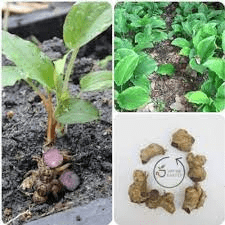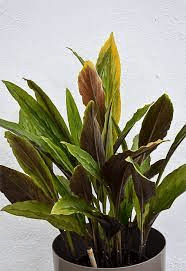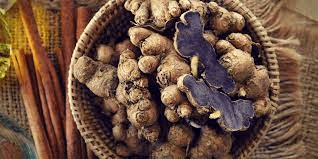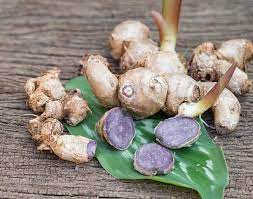Kaempferia parviflora, commonly known as Thai Ginseng or Black Ginger, is a herbaceous plant native to Thailand. It belongs to the ginger family, Zingiberaceae. This perennial plant is appreciated for its rhizomes, which are the underground stems, and it has been used traditionally in Thai folk medicine for various purposes.
The rhizomes of Kaempferia parviflora are the primary part of the plant utilized for their potential medicinal properties. These rhizomes are dark purple to black in color, contributing to the plant’s alternative name, “Black Ginger.” The rhizomes contain a variety of bioactive compounds, including flavonoids, terpenoids, and phenolic compounds.
In traditional medicine, Kaempferia parviflora is reputed for its adaptogenic properties, believed to help the body adapt to stress and enhance overall vitality. It has been used to address conditions such as fatigue, improve energy levels, and boost libido. Some traditional practices also associate it with anti-inflammatory and antioxidant effects.
Scientific research on Kaempferia parviflora has gained interest, particularly focusing on its potential as an herbal remedy. Studies have explored its effects on various physiological functions, including its impact on sexual function, exercise performance, and cognitive function.
However, it’s crucial to note that while there is some evidence supporting its traditional uses, further research is needed to fully understand its mechanisms of action, safety profile, and potential therapeutic applications.
In recent years, Kaempferia parviflora has also gained attention in the realm of sports nutrition and wellness, with some considering it as a natural supplement for promoting physical performance and vitality.
As with any herbal remedy, it is advisable to exercise caution, especially when considering its use for specific health conditions, and consultation with a healthcare professional is recommended.
The Botanical Description of Kaempferia Parviflora
1. Rhizomatous Growth: Kaempferia parviflora, commonly known as Thai ginseng or black ginger, is characterized by its rhizomatous growth. The rhizomes, underground stems, play a central role in the plant’s structure and function.
2. Leaves: The plant features long, lance-shaped leaves with prominent veins. These leaves emerge directly from the rhizomes and contribute to the overall aesthetic appeal of Kaempferia parviflora.
3. Inflorescence: Kaempferia parviflora produces inflorescences with small, tubular flowers. The inflorescence arises from the base of the plant and stands out against the green foliage.
4. Rhizome Color: The rhizomes of Kaempferia parviflora have a dark purple to blackish color, a distinctive characteristic that sets it apart from other species within the genus.
5. Height and Spread: The plant is relatively low-growing, reaching a height of about 15 to 30 centimeters. It forms dense clumps as the rhizomes spread horizontally.
6. Scent: Kaempferia parviflora is known for its aromatic qualities. When the rhizomes are crushed or cut, they release a pleasant fragrance, adding to the overall allure of the plant.
7. Dormant Period: The plant has a dormant period during the dry season, where the above-ground parts may die back, and growth is sustained by the underground rhizomes.
8. Texture: Both the leaves and rhizomes exhibit a smooth texture, contributing to the tactile appeal of Kaempferia parviflora.
9. Habitat: Indigenous to Southeast Asia, the plant thrives in tropical climates and is often found in the wild in countries like Thailand, Vietnam, and Cambodia.
10. Ornamental Value: Beyond its medicinal uses, Kaempferia parviflora is valued for its ornamental qualities, making it a popular choice in gardens and landscapes.
The Geographic Distribution of Kaempferia Parviflora

1. Southeast Asia: Kaempferia parviflora is native to Southeast Asian countries, including Thailand, Vietnam, Laos, and Cambodia.
2. Tropical Climate: The plant thrives in regions with a tropical climate, characterized by high temperatures and consistent rainfall throughout the year.
3. Altitude Range: Found in both lowland and upland areas, Kaempferia parviflora adapts to different altitudes, from sea level up to higher elevations.
4. Specific Habitats: The plant prefers habitats with well-draining soils, often found in the understory of tropical forests and along stream banks.
5. Cultivation: While native to the wild, Kaempferia parviflora is also cultivated in gardens and plantations for both its ornamental and medicinal purposes.
6. Human Influence: Human cultivation and trade have contributed to the spread of Kaempferia parviflora to regions beyond its native habitat.
7. Biotic Interactions: The plant interacts with various organisms in its ecosystem, including pollinators and soil microorganisms, influencing its distribution.
8. Adaptability: Kaempferia parviflora demonstrates adaptability to different soil types, provided they are well-draining, and can tolerate partial shade.
9. Conservation Status: While not currently listed as endangered, conservation efforts are essential due to the plant’s popularity and potential overharvesting.
10. Ethnobotanical Importance: Kaempferia parviflora holds cultural significance in traditional medicine and is utilized by local communities for its health-promoting properties.
11. Global Presence: Due to its popularity, Kaempferia parviflora has gained global attention, with interest in its cultivation and uses extending beyond its native regions.
12. Research and Conservation Initiatives: Ongoing research and conservation initiatives aim to understand and protect the natural habitats of Kaempferia parviflora.
The Chemical Composition of Kaempferia Parviflora
1. Polyphenols: Kaempferia parviflora is rich in polyphenolic compounds, including flavonoids and phenolic acids, which contribute to its antioxidant properties.
2. Alkaloids: The plant contains alkaloids, including kraemferin and other bioactive alkaloids that are of interest for their potential health benefits.
3. Essential Oils: Kaempferia parviflora produces essential oils with a complex composition, contributing to its aromatic qualities and potential therapeutic uses.
4. Terpenoids: Terpenoids, including sesquiterpenes, are present in Kaempferia parviflora and may contribute to its pharmacological activities.
5. Steroids: Certain steroids are found in the plant, and their role in the overall chemical profile is an area of ongoing research.
6. Gingerol Derivatives: Similar to ginger (Zingiber officinale), Kaempferia parviflora contains gingerol derivatives, which are known for their anti-inflammatory properties.
7. Diarylheptanoids: These compounds are unique to plants in the Zingiberaceae family, to which Kaempferia parviflora belongs, and have demonstrated various biological activities.
8. Anti-Inflammatory Compounds: The plant contains compounds with anti-inflammatory effects, making it of interest for conditions associated with inflammation.
9. Antioxidant Compounds: Kaempferia parviflora is known for its high antioxidant content, which may help combat oxidative stress in the body.
10. Flavonoids: Flavonoids, including quercetin and kaempferol, contribute to the plant’s antioxidant and anti-inflammatory properties.
11. Xanthones: Some xanthones are present in Kaempferia parviflora, and their potential health benefits are an area of ongoing research.
12. Anti-Cancer Properties: Preliminary studies suggest that certain compounds in the plant may have anti-cancer properties, warranting further investigation.
13. Immunomodulatory Effects: Compounds in Kaempferia parviflora may modulate the immune system, potentially enhancing immune function.
14. Anti-Diabetic Potential: Research indicates potential anti-diabetic effects, with compounds in the plant showing activity against diabetes-related pathways.
15. Neuroprotective Compounds: Some constituents of Kaempferia parviflora exhibit neuroprotective effects, suggesting possible benefits for cognitive health.
Read Also: 15 Medicinal Health Benefits Of Dendrocnide sinuata (Stinging Tree)
The Medicinal Health Benefits Of Kaempferia Parviflora (Thai Ginseng)

1. Energy and Vitality: Kaempferia parviflora is traditionally used to promote energy and vitality. It is believed to enhance stamina and combat fatigue.
2. Adaptogenic Qualities: As an adaptogen, Kaempferia parviflora may help the body adapt to stressors, supporting overall resilience.
3. Sexual Health: The plant is known for its traditional use in supporting male sexual health, with claims of enhancing libido and addressing certain sexual dysfunctions.
4. Anti-Inflammatory Effects: Compounds in Kaempferia parviflora may exhibit anti-inflammatory effects, potentially beneficial for conditions involving inflammation.
5. Antioxidant Support: The high antioxidant content contributes to the plant’s ability to combat oxidative stress, supporting overall health.
6. Digestive Health: Traditional uses include remedies for digestive issues, with the plant believed to have soothing effects on the digestive system.
7. Immune System Modulation: Compounds in Kaempferia parviflora may modulate the immune system, potentially enhancing immune function.
8. Cognitive Enhancement: Some studies suggest potential cognitive benefits, including improved memory and cognitive function.
9. Joint Health: Traditional uses include remedies for joint-related issues, with claims of alleviating discomfort and promoting joint health.
10. Anti-Diabetic Effects: Research indicates potential benefits for individuals with diabetes, with compounds showing activity against diabetes-related pathways.
11. Cardiovascular Support: Preliminary studies suggest cardiovascular benefits, including potential effects on blood pressure and heart health.
12. Anti-Cancer Properties: While not proven, certain compounds in Kaempferia parviflora have shown anti-cancer potential in preliminary studies, necessitating further research.
13. Weight Management: Some traditional uses involve the plant’s role in weight management, with claims of supporting a healthy metabolism.
14. Anti-Anxiety and Stress Relief: Kaempferia parviflora is traditionally used for its calming effects, potentially aiding in anxiety relief and stress management.
15. Anti-Aging Properties: Compounds in the plant may contribute to anti-aging effects, with antioxidant and adaptogenic qualities.
16. Respiratory Health: Traditional uses include remedies for respiratory issues, suggesting potential benefits for respiratory health.
17. Liver Health: Some compounds may have hepatoprotective effects, supporting liver health and function.
18. Anti-Bacterial and Anti-Fungal Effects: Preliminary studies indicate potential antibacterial and antifungal properties, warranting further exploration.
The Methods of Usage to Achieve the Provided Health Benefits Of Kaempferia Parviflora (Thai Ginseng)
1. Traditional Decoctions: Prepare decoctions by boiling Kaempferia parviflora rhizomes in water to extract beneficial compounds.
2. Powdered Form: Ground rhizomes can be consumed in powdered form, added to beverages, smoothies, or food for easy incorporation.
3. Capsules or Supplements: Kaempferia parviflora is available in supplement form, providing a convenient and standardized dosage.
4. Tinctures: Extracts of the plant can be prepared in alcohol or other solvents, allowing for easy administration and absorption.
5. Topical Applications: Creams or oils containing Kaempferia parviflora extracts can be applied topically for skin-related benefits.
6. Culinary Uses: Some cultures incorporate Kaempferia parviflora into culinary dishes, adding a unique flavor while reaping potential health benefits.
7. Herbal Teas: Infuse Kaempferia parviflora in hot water to make herbal teas, which can be a soothing way to consume the plant.
8. Combination Formulations: Combine Kaempferia parviflora with other herbs or supplements to create customized formulations for specific health goals.
9. Aromatherapy: Utilize the aromatic qualities of Kaempferia parviflora through aromatherapy for relaxation and stress relief.
10. Ritualistic Uses: In certain traditional practices, Kaempferia parviflora may be used in rituals or ceremonies for spiritual or symbolic purposes.
11. Blending with Beverages: Incorporate powdered Kaempferia parviflora into beverages like smoothies, juices, or herbal drinks for an enjoyable and health-promoting option.
12. Integration into Daily Routines: Develop creative ways to integrate Kaempferia parviflora into daily routines, making it a sustainable and enjoyable part of a wellness regimen.
The Side Effects Of Using Kaempferia Parviflora Medicinal Plant
1. Allergic Reactions: Some individuals may experience allergic reactions, such as skin rashes or itching, when using Kaempferia parviflora.
2. Gastrointestinal Discomfort: Excessive consumption may lead to gastrointestinal discomfort, including nausea or indigestion.
3. Interaction with Medications: Kaempferia parviflora may interact with certain medications, affecting their effectiveness or metabolism. It is advisable to consult with a healthcare professional before using the plant alongside medications.
4. Blood Pressure Impact: Individuals with existing blood pressure concerns should monitor their levels regularly, as Kaempferia parviflora may influence blood pressure.
5. Pregnancy Concerns: Pregnant women should exercise caution, and it’s advisable to consult healthcare professionals before using Kaempferia parviflora due to potential effects on pregnancy.
6. Breastfeeding Precautions: Lactating women should use Kaempferia parviflora with caution, as its effects on breastfeeding are not well-documented.
7. Central Nervous System Effects: Some individuals may experience changes in alertness or mood, and careful observation is necessary, especially if there is a history of neurological conditions.
8. Not for Everyone: While generally considered safe for many individuals, Kaempferia parviflora may not be suitable for everyone. Individual responses can vary, and it’s crucial to pay attention to personal tolerance.
9. Potential Liver Impact: Prolonged and excessive use may impact liver health, necessitating regular liver function checks for those using Kaempferia parviflora over an extended period.
10. Photosensitivity: Sensitivity to sunlight may increase in some individuals using Kaempferia parviflora, requiring appropriate sun protection measures.
11. Respiratory Sensitivity: Individuals with respiratory conditions may experience sensitivity to inhaled forms of Kaempferia parviflora, and caution is advised.
12. Fertility Concerns: Due to potential hormonal influence, individuals with fertility concerns should use Kaempferia parviflora cautiously.
13. Not a Substitute for Medical Advice: Kaempferia parviflora should not replace professional medical advice or treatments for specific health conditions. It is essential to consult healthcare professionals for personalized guidance.
14. Potential Gastrointestinal Issues: Some individuals may experience gastrointestinal issues such as bloating or flatulence, and adjusting the dosage may be necessary.
Read Also: How to Grow, Use and Care for Wolftail Sedge Grass (Carex cherokeensis)
The Scientific Research and Studies of Kaempferia Parviflora

1. Anti-Inflammatory Properties: Scientific studies have explored the anti-inflammatory effects of Kaempferia parviflora, elucidating potential mechanisms and applications for inflammatory conditions.
2. Antioxidant Activity: Research focuses on the antioxidant activity of Kaempferia parviflora, evaluating its effectiveness in combating oxidative stress and supporting overall health.
3. Aphrodisiac Effects: Some studies investigate the plant’s traditional use as an aphrodisiac, exploring potential mechanisms and applications for sexual health.
4. Anti-Diabetic Potential: Scientific studies delve into the potential anti-diabetic effects of Kaempferia parviflora, examining its impact on glucose metabolism and insulin sensitivity.
5. Cognitive Function: Research explores the impact of Kaempferia parviflora on cognitive function, including memory enhancement and neuroprotective effects.
6. Cardiovascular Health: Studies investigate the potential cardiovascular benefits of Kaempferia parviflora, including its effects on blood pressure and heart health.
7. Anti-Cancer Properties: Preliminary research suggests that certain compounds in Kaempferia parviflora may have anti-cancer properties, with studies focusing on specific cancer types.
8. Safety Profiles: Scientific studies aim to establish the safety profiles of Kaempferia parviflora, including potential side effects and interactions with medications.
The Safety Precautions and Recommendations In Using Kaempferia Parviflora Medicinal Plant
1. Dosage Moderation: Use Kaempferia parviflora in moderation, adhering to recommended dosages to minimize the risk of adverse effects.
2. Consultation with Healthcare Professionals: Seek advice from healthcare professionals before using Kaempferia parviflora, especially if pregnant, lactating, or on medications.
3. Monitor Blood Pressure: Individuals with blood pressure concerns should monitor levels regularly when using the plant.
4. Regular Liver Function Checks: Prolonged use may impact liver health. Regular liver function checks are advisable, especially for those using Kaempferia parviflora over an extended period.
5. Allergic Sensitivity: Individuals with known allergies or sensitivities should perform patch tests before using Kaempferia parviflora topically, minimizing the risk of allergic reactions.
6. Avoid Excessive Consumption: To prevent gastrointestinal discomfort and other potential side effects, avoid excessive consumption of Kaempferia parviflora.
7. Sun Protection: If using forms of Kaempferia parviflora that may increase photosensitivity, such as topical applications, take appropriate measures for sun protection.
8. Pregnancy and Breastfeeding: Pregnant or breastfeeding women should exercise caution, and it’s advisable to consult healthcare professionals before using Kaempferia parviflora due to potential impacts on pregnancy and breastfeeding.
9. Individual Variations: Recognize that individuals may respond differently to herbal remedies, and effects can vary based on factors such as age, health status, and existing medical conditions.
10. Discontinue in Case of Adverse Effects: If any adverse effects or discomfort occur while using Kaempferia parviflora, discontinue its use and seek medical advice promptly.
11. Interactions with Medications: Be aware of potential interactions with medications, and inform healthcare providers about the use of Kaempferia parviflora when seeking medical advice or treatment.
12. Caution for Children: Exercise caution when considering the use of Kaempferia parviflora for children, and consult with healthcare professionals for appropriate guidance.
13. Storage Conditions: Store Kaempferia parviflora products in appropriate conditions to maintain their quality and potency. Follow recommended storage guidelines.
14. Ethical Harvesting Practices: If sourcing Kaempferia parviflora from the wild, promote ethical harvesting practices to ensure the sustainability of the plant and its ecosystem.
15. Legal Considerations: Be aware of the legal status of Kaempferia parviflora in your region, ensuring compliance with regulations governing the use and trade of medicinal plants.
16. Educate Yourself: Stay informed about the latest research, safety guidelines, and cultural considerations related to the use of Kaempferia parviflora.
FAQs About Kaempferia Parviflora Medicinal Plant
1. Is Kaempferia Parviflora Safe for Daily Use?
While generally considered safe, it’s advisable to use Kaempferia parviflora in moderation. Regular consultation with healthcare professionals is recommended.
2. Can Kaempferia Parviflora Be Used During Pregnancy?
Pregnant women should exercise caution, and it’s advisable to consult healthcare professionals before using Kaempferia parviflora due to potential impacts on pregnancy.
3. Are There Any Known Drug Interactions with Kaempferia Parviflora?
Certain medications may interact with Kaempferia parviflora. It’s crucial to inform healthcare providers about its use to prevent potential interactions.
4. How Long Does It Take to Experience the Medicinal Benefits of Kaempferia Parviflora?
The time it takes to experience benefits may vary. Some individuals may notice effects sooner, while others may require more extended usage.
5. Can Kaempferia Parviflora Be Used Topically for Skin Conditions?
Yes, extracts or oils from Kaempferia parviflora can be applied topically for certain skin conditions. However, perform a patch test and discontinue use if irritation occurs.
6. Is Kaempferia Parviflora Suitable for Children?
Exercise caution when considering the use of Kaempferia parviflora for children. Consult with healthcare professionals for appropriate guidance.
7. Are There Any Ritualistic Uses of Kaempferia Parviflora?
In certain traditional practices, Kaempferia parviflora may be used in rituals or ceremonies for spiritual or symbolic purposes.
8. Can Kaempferia Parviflora Be Used Alongside Other Herbal Remedies?
Yes, Kaempferia parviflora can be combined with other herbs or therapies for synergistic health effects. However, consult healthcare professionals for personalized advice.
9. How Can I Ensure the Sustainable Harvesting of Kaempferia Parviflora?
Promote ethical harvesting practices, follow local regulations, and support initiatives that promote the sustainable use of medicinal plants.
10. Are There Any Known Cases of Allergic Reactions to Kaempferia Parviflora?
Some individuals may experience allergic reactions, including skin irritation or respiratory symptoms. Perform patch tests before using topically.
11. Can Kaempferia Parviflora Impact Blood Pressure?
Individuals with existing blood pressure concerns should monitor their levels regularly, as Kaempferia parviflora may influence blood pressure.
12. How Does Kaempferia Parviflora Contribute to Gastrointestinal Health?
Kaempferia parviflora may offer benefits for gastrointestinal health, with traditional uses suggesting potential relief for certain digestive issues.
13. Is Kaempferia Parviflora Suitable for Respiratory Conditions?
While traditional uses imply potential benefits for respiratory conditions, individuals with respiratory issues should exercise caution and consult healthcare providers.
14. Can Kaempferia Parviflora Be Used for Pain Management?
The anti-inflammatory properties of Kaempferia parviflora may contribute to pain relief, making it relevant in traditional pain management.
15. How Should Kaempferia Parviflora Be Incorporated into Daily Routines?
Depending on the intended use, Kaempferia parviflora can be consumed as infusions, tinctures, or topical applications. Consultation with healthcare professionals is advised.
16. What Are the Traditional Ritualistic Uses of Kaempferia Parviflora?
In some cultures, Kaempferia parviflora may be used in rituals or ceremonies for spiritual or symbolic purposes, emphasizing its cultural significance.
17. Can Kaempferia Parviflora Enhance Cognitive Function?
Preliminary research suggests potential benefits for cognitive function, including memory and alertness, but more studies are needed in this area.
18. Is Kaempferia Parviflora Safe for Long-Term Use?
While generally considered safe, long-term use of Kaempferia parviflora may impact liver health. Regular liver function checks and professional advice are recommended.
19. Does Kaempferia Parviflora Have Hormonal Effects?
Some studies explore the potential hormonal effects of Kaempferia parviflora, particularly in relation to menstrual disorders and fertility.
20. What Are the Antioxidant Properties of Kaempferia Parviflora?
The presence of flavonoids and other antioxidants in Kaempferia parviflora contributes to its ability to combat oxidative stress and promote overall health.
Read Also: What Are The Benefits Of A Career In Agriculture?


Like your post and Information
Thank you so much and we are glad that you find our article very helpful